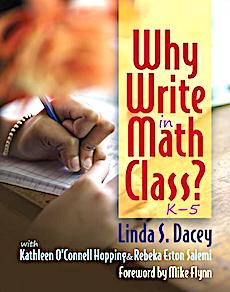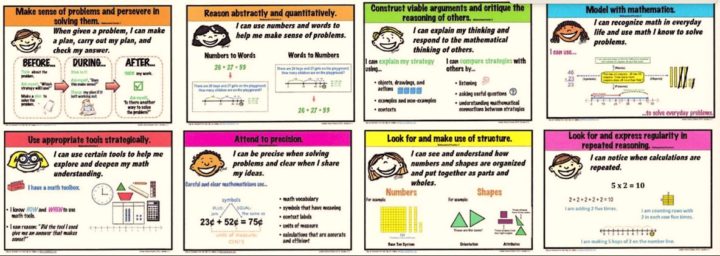Writing Activities That Build Math Learning
Why Write in Math Class? K-5
By Linda Dacey with Kathleen O’Connell Hopping and Rebeka Eston Salemi
(Stenhouse Publishers, 2018 – Learn more)
Reviewed by Helene Alalouf
 Please do not scroll away if you are not a math teacher or in an elementary grade! Teachers in grades 4-8, across the content areas, can benefit from this very helpful resource.
Please do not scroll away if you are not a math teacher or in an elementary grade! Teachers in grades 4-8, across the content areas, can benefit from this very helpful resource.
As both a literacy and math coach, I frequently cross-pollinate the strategies of one to the other, such as making thinking visible with models and diagrams, and using argument to justify a solution or text-based claim, across grades and disciplines.
 The writer’s notebooks of my own students were replete with seeds for future writing, double entry reading logs, and personal angst and reflections that, transformed into prose, annually found public voice in anthologies.
The writer’s notebooks of my own students were replete with seeds for future writing, double entry reading logs, and personal angst and reflections that, transformed into prose, annually found public voice in anthologies.
I assure you that the strategies and prompts in this gem of a book, Why Write in Math Class? K-5, will ignite your students’ thinking, just as The Writing is Thinking through Strategic Inquiry movement has raised secondary students’ reading and college readiness in NYC schools and beyond.
Every time I thought I’d found my favorite chapter in Why Write in Math Class K-5, the next one presented additional engaging ways to use writing to implement the Common Core/Next Generation Standards for Mathematical Practices (displayed here, student-style – click to enlarge):

The Rationale
Why do we want our students to write in math class? “Writing helps students construct and represent knowledge, make connections between conceptual understanding and procedural fluency, and engage in mathematical communication” (Burns 1995; Countryman 1992; Pugalee 2005 – cited in Dacey, p. 3).
“We need to reframe our stance from How can we expect all of our students to write about math? to How does what I know about teaching writing and facilitating math talk help me foster mathematical writing in all of my students?” (Dacey, p.26).
By employing purposeful discourse prompts and strategies for writing, teachers can help students “learn what mathematical explorations, explanations, and reasoning look like and what it means to describe or justify their thinking” (p.46).
While tasks can have multiple purposes, a chapter is devoted to each type, both free styles and structured, with students’ writing samples and teachers’ insights to support the development of number sense, academic language, and reasoning. Teachers’ feedback is critical for growth so Dacey describes several ways to offer it throughout the book:
- Goal-related scaffolding
- Actionable formative feedback
- Voice over comments while circulating the room
- Conferencing
- Running records
- Peer review
Beginning with Chapter 4, Dacey takes a deeper look at five reasons for writing in math class. What she has to say is so valuable that I’ve summarized some key points from each of these chapters in these notes.
Chapter 4 – Writing to Explore
- To make meaning by defining concepts and symbols in their own words. Ex: What does = mean to you?
- Use the strategy of Elaborate! to record all you know for this situation: Three buses were needed to take the 124 fifth graders to the science museum.
- To make sense of a task, write and draw first, then write the equation to solve
- To annotate what you notice in daily math routines such as Which One Doesn’t Belong?
- To make predications, like Three Act tasks.
- To explore new thinking by looking at others’ writing. Compare representations and find patterns. What do you notice about the different ways the class represented the number? What does the number…mean?
Chapter 5 – Writing to Describe and Explain (informative writing)
- To show your work/To explain your thinking, using visual models/representations, labeling your calculations/strategies, writing the equations and an answer statement.
- In peer review: Tell how your work is the same or different.
- To explain how to use a procedure or analyze an error.
- To describe and explain mathematical tools, such as how to use tally marks or a ruler.
- To find math everywhere: in nature, in non-fiction texts, in personal lives; organize numerical data.
Chapter 6 – Writing to Justify and Convince (argumentative writing)
- To build theories with visual models and construct viable arguments
Mr. Z predicts that the combined runs of today’s Red Sox game with the Pittsburgh Pirates will be 16. What are the possible combinations of runs for the two teams? - Use the strategy I Don’t Agree! with Always true, Sometimes true, or Never true, for numberless stories or statements such as:
- Is zero a number?
- When you cut a rectangle to make its area smaller, its perimeter also gets smaller.
Chapter 7 – Writing to Connect Mathematics and Creativity (personal writing)
- To express originality, fluency and flexibility or elaborate thinking
- To write your own word problem, with given criteria, such as
- either addition or subtraction and
- multiplication
- To retell a math story with different numbers
- For any mentor text, to add mathematical models or a sidebar character to give math-related facts
- To imitate The Day the Crayons Quit from the narrator’s voice of a number or math tool
- To write a two-voice poem, such as multiplication and division, perimeter and area, decimals and fractions, numerator and denominator, inch and foot, penny and dollar.
Chapter 8 Writing to Reflect (metacognitive writing)
- Journals, math notebooks, and learning logs
- For error analysis and revision
- Use the strategy of What We Forgot to Do to improve work
- Use the strategy of Which Would You Rather Use? to compare strategies, solutions, tools, and concepts to solve a problem.
- a number line and a hundreds chart
- a clock and a ruler
- two bar graphs with the same labels but different data
- fractions and decimals
- Model how to review work to show growth over time
Next Steps
If you are still skeptical and perhaps (shudder) believe all learners are not ready for the rigors and expression of writing across content areas, please discuss in your next teacher team meeting Donald Graves’ article All Children Can Write, WETA 2021. Two takeaways from that article are:
“When I write, I write to learn what I know because I don’t know fully what I mean until I order the words on paper. Then I see … and know… Writing makes sense of things for oneself, then for others.”
“Four essentials to a successful writing-process program are described: the adequate provision of time (at least 4 days per week), child choice of writing topic, response to child meaning, and the establishment of a community of learners.”
Why Write in Math Class? K-5 shows us the “write” way to “account” for all four!
Since attaining her Masters from Teachers College, Columbia University, and later National Board Certification, education consultant Helene Alalouf relishes opportunities to share her passion and informed fluency of research-evident principles to ensure a productive learning environment, cognitively and affectively, to support educators and families in realizing their vision. At leisure, she enjoys walking and cooking with family and friends, reading, and knitting.

































